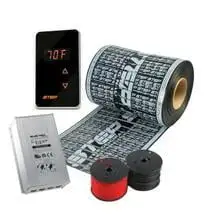Radiators have been around a long time – everyone recognizes a radiator when they see one. Many of us already know some of the advantages and disadvantages of radiators, too. But do you know how radiators compare to heated floors?
Heated floors use modern technology and radiant heat to keep homes and interior spaces comfortable and warm. Compared to radiators, heated floors provide extra comfort and greater efficiency. Knowing the differences between these two types of heating can help you decide which heating is right for your upcoming renovation or building project.
How Do Radiators Work?
Radiators are made from metal, a great conductor of heat. As hot water or steam travels through the radiator, the radiator fins heat up, which in turn heats up the air surrounding the radiator.
Radiators are designed with fins to increase the radiator surface area, so they can heat up more air and heat spaces more quickly. Radiators don’t have blowers. Instead, the air that heats up around the radiator rises, which makes room for cooler air to take its place. This starts a cycle of air rising and flowing toward the radiator, which helps heat the room where the radiator is located.
Pros and Cons of Radiator Heating
Pro – Radiators are familiar.
Radiators are a very old technology, so they’re very common. Many homes still use radiator heat to stay warm. This means that many people are already used to radiators and understand how to make them work.
Pro – Quick blast of heat.
Radiators work relatively quickly to do the job of heating a room. While not very efficient, they can heat large spaces.
Con – Inefficient. Radiators were never made to be efficient – they were just made to be effective. There are more modern ways of heating a space that are far more efficient than radiator heating.
Con – Uneven heating makes problems.
Radiators don’t heat spaces evenly, so some homeowners will turn up the thermostat too high in an effort to get heat to the parts of the room far away from the radiator. This can lead to some spaces being warmer and some spaces being colder.
Con – Safety. Radiators get very hot.
Falling onto or touching a radiator accidentally can lead to injuries. In a house with a child, a radiator can be an area of concern.
Con – Takes up space in the room.
Radiators take up wall space – sometimes a very important part of the wall. And, depending on where the radiator is located, it may get in the way of foot traffic as well.
How do Radiant Floor Heating Systems Work?
Radiant floor heating systems produce heat through thermal radiation. These systems heat the floor, thus providing indirect heat that comes from the ground up.
Once the floor is warmed up, then objects on the floor also warm up. These objects then help heat up the surrounding room. Entering a room, the heat feels like it is coming from everywhere – because it is. Rooms heated with heated floors are exceptionally comfortable.
Pros and Cons of Heated Floors
Pro – Even heating throughout the room.
There are no cold spots or droughts when you’re heating your room with floor heating. The room becomes evenly warm as the heat spreads throughout the floor.
Pro – Up to 25% more efficient.
Under floor heating uses a lower water temperature to heat the room, and requires less energy to heat a home’s interior spaces.
Pro – Easy to control zoned heating. Whereas many homes have just one thermostat to control the whole house, thermal heating can be controlled zone by zone, which gives homeowners a greater deal of control over their temperature and comfort.
Pro – It takes up no space in the room.
Unlike a radiator, which sticks out from the wall, floor heating is underneath the floor – invisible to the eye, creating no obstructions in the house.
Pro – Safety.
There are no hot surfaces to touch and burn yourself on with floor heating. The gentle heat rising from the floor is comfortable, not painful. This makes floor heating safer in homes with small children.
Pro – Aesthetic flexibility.
Unlike radiators, which take up a significant amount of space and also impact the interior design of the home, floor heating is invisible. This allows you to design the room the way you want it designed, without any considerations for large heating elements in the room.
Con – Price.
The cost of an in-floor heating system can be higher than the installation of a radiator, because installation often takes longer. However, because the flooring is more efficient, homeowners often recover their costs later, with lower utility bills.
Have More Questions? Call Green Wave Distribution
Floor heating technology is relatively new, so some people have questions about this type of flooring before they’re ready to buy and install. For more information about this type of flooring for an upcoming project, contact Green Wave Distribution today. We’ll be happy to answer any questions that you have about radiant heat, heated floors vs radiators, and heating flooring installation.
Or, check out some of our other radiant heaters like our radiant panels below:






